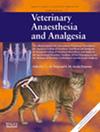超声引导下兔尸体肋间神经注射:技术描述及与盲入路的比较。
IF 1.9
2区 农林科学
Q2 VETERINARY SCIENCES
引用次数: 0
摘要
目的:探讨超声引导下兔肋间神经阻滞的治疗方法,并比较其与盲注射的成功率和潜在并发症。研究设计:前瞻性、随机、盲法、描述性尸体实验研究。动物:9具成年家兔尸体(体重1.8-2.4 kg)。方法:通过解剖一具尸体,确定解剖标志,发展超声引导技术。8具尸体在一侧半胸进行盲注射,在另一侧半胸进行超声引导注射。每次治疗使用的侧边是随机分配的。两种技术均以第三至第九肋间神经为靶点,每个部位注射0.1 mL黄色染料溶液。在超声引导下注射时评估胸膜壁层内侧移位。注射后解剖家兔,如果肋间神经周围染色,则认为注射成功。此外,评估胸膜壁层的内部是否存在游离染料,以确定是否发生胸膜壁层穿孔。采用Fisher精确检验比较两种注射方式的染色神经数量和胸膜穿孔发生率。以p < 0.05为差异有统计学意义。结果:共行盲肋间注射56例,超声引导下56例。盲法和超声引导法的成功率分别为35.7%和66.0% (p = 0.002)。胸膜内侧染色在盲注射组为23.2%,超声引导注射组为21.4%,两组间差异无统计学意义(p < 0.05 0.999)。结论及临床意义:与盲法相比,超声引导可提高肋间神经注射的准确性;然而,胸膜穿刺是两种技术进行肋间注射时常见的并发症。本文章由计算机程序翻译,如有差异,请以英文原文为准。
Ultrasound-guided intercostal nerve injection in rabbit cadavers: Technique description and comparison with blind approach
Objective
To develop an ultrasound-guided technique for intercostal nerve blocks in rabbit cadavers and to compare the success rate and potential complications of this technique to blind injection.
Study design
Prospective, randomized, blinded, descriptive experimental cadaveric study.
Animals
A group of nine adult domestic rabbit cadavers (body mass 1.8–2.4 kg).
Methods
Anatomic landmarks were identified by dissection of one cadaver and used to develop the ultrasound-guided technique. Eight cadavers were administered blind injections on one hemithorax and ultrasound-guided injections on the opposite hemithorax. The side used for each treatment was randomly assigned. For both techniques, the third to ninth intercostal nerves were targeted and 0.1 mL of yellow dye solution was injected per site. Medial displacement of the parietal pleura was assessed during ultrasound-guided injections. Rabbits were dissected following injection, and injections were considered successful if the circumference of the intercostal nerve was stained with dye. Additionally, the internal aspect of the parietal pleura was assessed for the presence of free dye to determine whether perforation of the parietal pleura had occurred. The number of stained nerves and incidence of pleural perforations were compared between injection techniques using Fisher’s exact test. Data were considered statistically different if p < 0.05.
Results
A total of 56 blind and 56 ultrasound-guided intercostal injections were performed. Success rates of the blind and ultrasound-guided techniques were 35.7 % and 66.0 %, respectively (p = 0.002). The internal aspect of the pleura was stained in 23.2 % of blind and 21.4 % of ultrasound-guided injections, with no significant difference between groups (p > 0.999).
Conclusions and clinical relevance
Ultrasound guidance improves the accuracy of intercostal nerve injections when compared with a blind technique; however, pleural puncture is a common complication when performing intercostal injections with both techniques studied.
求助全文
通过发布文献求助,成功后即可免费获取论文全文。
去求助
来源期刊

Veterinary anaesthesia and analgesia
农林科学-兽医学
CiteScore
3.10
自引率
17.60%
发文量
91
审稿时长
97 days
期刊介绍:
Veterinary Anaesthesia and Analgesia is the official journal of the Association of Veterinary Anaesthetists, the American College of Veterinary Anesthesia and Analgesia and the European College of Veterinary Anaesthesia and Analgesia. Its purpose is the publication of original, peer reviewed articles covering all branches of anaesthesia and the relief of pain in animals. Articles concerned with the following subjects related to anaesthesia and analgesia are also welcome:
the basic sciences;
pathophysiology of disease as it relates to anaesthetic management
equipment
intensive care
chemical restraint of animals including laboratory animals, wildlife and exotic animals
welfare issues associated with pain and distress
education in veterinary anaesthesia and analgesia.
Review articles, special articles, and historical notes will also be published, along with editorials, case reports in the form of letters to the editor, and book reviews. There is also an active correspondence section.
 求助内容:
求助内容: 应助结果提醒方式:
应助结果提醒方式:


